Kansas City on the right track
As the Streetcar route advances, so does the city’s momentum
There are many parts of Kansas City seeing significant growth, but no more than the area along the Kansas City Streetcar route. The existing line, running from the River Market on the north end to Union Station and Crown Center on the south, was finished in 2016 and today has made more than 9 million trips. The KC Streetcar connects all the downtown neighborhoods with 16 platform stops and two miles of track. Along that line of track, construction projects have been steady. And with two new expansions — south down Main Street all the way to the University of Missouri-Kansas City and north along the Riverfront, ending at Berkley Riverfront Park — construction projects are already underway in anticipation of the economic growth as a result of the Streetcar line.
With construction projects in process and more expected, opportunity beckons for Kansas City’s construction industry. As more projects come on line to bid, those who have already walked the path share their insights for maximizing success on future projects.
Lessons learned
When it comes to building along the Streetcar route, the team at A.L. Huber Inc. doesn’t let the location intimidate them. While there might be a few more hoops to jump through and logistics to plan, Phil Thomas, CEO and president at A. L. Huber, says they approach a downtown job just like they do any other — with detailed planning and precision.
“The key component for the success of a downtown project is a well-thought-out plan. If you have a great plan, a downtown project isn’t any more difficult; it just may require a little more planning,” he said.
Bidding these projects follows the approach used for all projects, with extra considerations made to circumstances unique to the area. For instance, on their recent Commerce Bank Main Street project, its downtown location along the Streetcar route required that they set the large sheets of exterior glass overnight. This adjustment was planned early and included in the estimate.
To place the exterior glass, the A. L. Huber team worked closely with the Kansas City Area Transportation Authority to create a plan to set the glass on the project between midnight and 5 a.m. Each night the power to that section of the Streetcar was shut off. It was critical all work be 100% complete and cleaned up prior to the Streetcar coming back online.
Timing and planning were key throughout the entire project — both from a big-picture standpoint down to the minutiae.

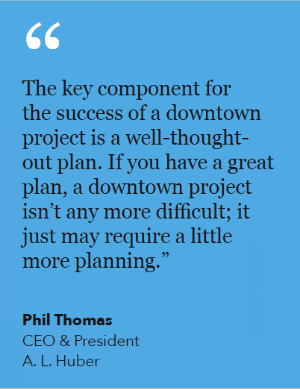
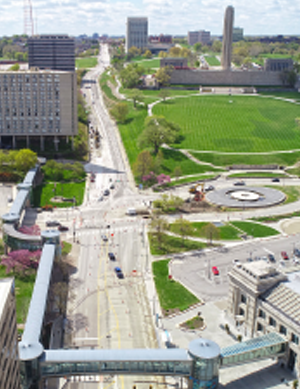
Left: Phil Thomas, CEO and president at A.L. Huber Inc., shares his insight for success, crediting well-thought-out plans as key drivers. The general contractor has completed several projects along the Streetcar route. Photo by Diana Gonzalez.
Right: The current Streetcar route is a two-mile track with 16 stops between the Rivermarket on the north side and Union Station on the south side. Since its completion in 2016, the Streetcar has made more than 9 million trips. It provides residents with improved access to both work and play, as well as supports Kansas City’s tourism initiatives — a win-win for the city. Photo courtesy of Andrew Patch with Heartland Drone Company.
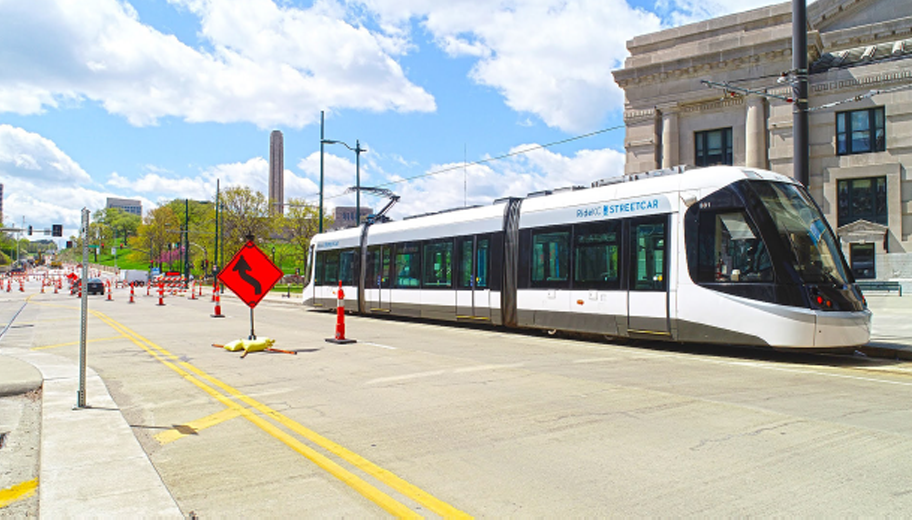
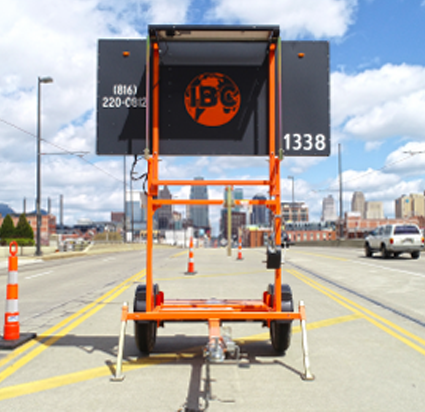
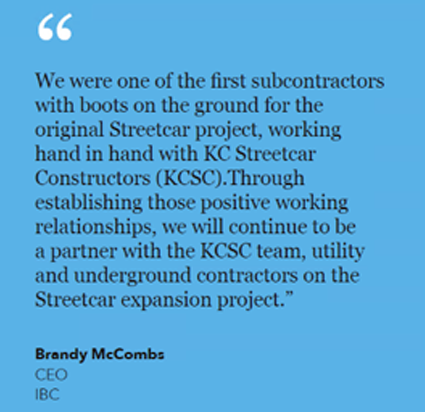
Top: The south expansion, which begins at the Union Station, will consist of eight additional stops. Proposed stop locations were evaluated against several key criteria including pedestrian demand and economic development potential.
Bottom: An arrow board helps direct traffic along Main Street. IBC Traffic, Inc. maintains directional signage to keep traffic moving, while giving Streetcar contractors space to work.
Photos courtesy of Andrew Patch with Heartland Drone Company.
Delivery trucks cannot idle along the Streetcar route, so the on-site team was continuously managing these kinds of minor details throughout the duration of the project.
Understanding the Streetcar zone regulations and planning the work accordingly is one of the biggest pieces of advice Thomas has for other general contractors considering bidding downtown work.
With many downtown projects under their belt, including the recent completion of The Church of the Resurrection downtown, the first new out-of-the-ground church construction in Kansas City in 80 years, A. L. Huber is looking forward to many more successful downtown projects.
Safety first
Safety has always been paramount on any job site, but projects located in urban settings with increased foot traffic require an expanded safety focus. Jacob Jenkins, safety specialist at JE Dunn Construction Company, says that the top priority when it comes to downtown projects is the safety of the public.
“Public protection is one of the first topics of conversation during the project preplanning stages months before a project is scheduled to begin,” he said. “The major topics typically considered first are overhead protection, traffic control and site security.”
For projects along the Streetcar route, there’s an added layer of precaution. Jenkins and team work closely with the KC Streetcar Authority Operations Team throughout the duration of projects to obtain authorization through employee training and work permitting to ensure the safety of both the public and their employees.
Through working on a number of downtown projects, the JE Dunn team has continued to adapt and evolve their processes to ensure optimum safety on each job site.
“The biggest lesson I’ve learned is that it’s never too early to get out ahead of the project and start planning,” Jenkins said. “Taking the time to collaborate early with your project team, your client and any other potentially affected entity, such as the KC Streetcar, is extremely valuable.”
His advice to others: Don’t be afraid to ask questions and use your resources. Chances are someone else has faced this same challenge and would be willing to share their insight. The construction industry plays an important role in propelling Kansas City forward, and working together will strengthen that role.
Traffic planning
The Streetcar has brought opportunities for local subcontractors beyond those focused on the buildings surrounding its path. Focused initially on carpentry work and general contracting support, Kansas City-based IBC, Inc. opened a traffic controls business arm in 2014 to expand their business and diversify their offerings. That revenue stream was vital during the pandemic when much of their other work was specific to confined spaces.
The IBC Traffic, Inc. team is a traffic control equipment rental and road striping service partner. Most projects include pulling city permits for road closures, setting these closures up with the required equipment, and directing the community safely through these detours. After completing these road and highway repairs, the team returns to stripe the lines.
“We were one of the first subcontractors with boots on the ground for the original Streetcar project, working hand in hand with KC Streetcar Constructors (KCSC),” Brandy McCombs, CEO of IBC, said. “Through establishing those positive working relationships, we will continue to be a partner with the KCSC team, utility and underground contractors on the Streetcar expansion project.”
As the teams prepare the track’s infrastructure, Main Street is already a sea of orange cones and arrow boards. All hands are on deck as the teams plan for this next phase of work.
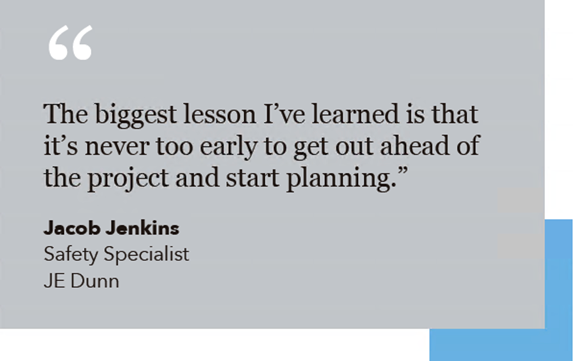

Tight, urban environments require additional safety protocols to ensure pedestrians remain out of harm’s way. Jacob Jenkins, safety specialist with JE Dunn, explains their approach to ensuring the safety of the public, as well as their own employees. Photo by Diana Gonzalez.
Marketing success
There are many opportunities to leverage these high-trafficked areas to support companies’ own marketing and brand awareness goals. MMC Contractors National, Inc., a specialty contracting firm in the mechanical trades, became a Builders’ member in 1985. The marketing team at MMC Corp, the parent company over MMC Contractors National, provides support to their subsidiaries across the country and throughout a number of urban environments.
“We work closely with our team on-site to uncover the best opportunities, materials and messages to promote at these job sites,” Erica Jones, vice president of marketing at MMC Corp, said. “We push ourselves to try to think outside the box on new, interesting ways we might promote our business. Rules and regulations are different everywhere, so it’s important we stay within the confines of what’s allowed.”
On many projects with a tight, urban footprint, finding these opportunities can be tricky. At a minimum, there is likely the option for branded fencing, but the MMC Corp team has come up with other interesting marketing canvases over the years: utilizing construction equipment already on-site (a crane or buck hoist for example), window clings, billboards on the side of buildings — just to name a few.
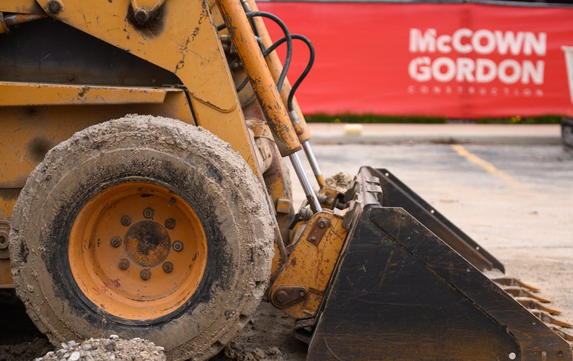
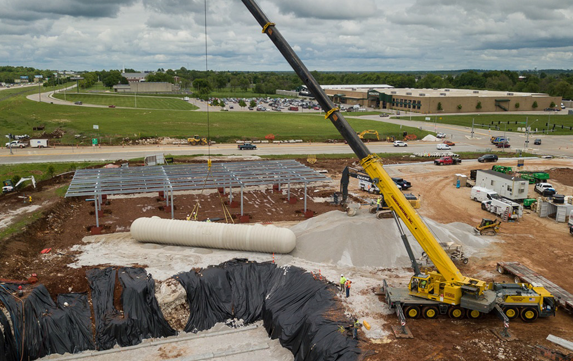
Left: Maximizing marketing opportunities along the Streetcar route sometimes requires out-of-the-box thinking. McCownGordon Construction displays fencing with their logo at a site under construction to raise brand awareness.
Right: Utilizing on-site construction equipment, as Carson-Mitchell, Inc. does here, to promote your brand is one recommendation MMC Corp offers to others looking to capitalize on marketing opportunities in high-traffic areas.
Photos by Miles Boyer.
“Depending on the project, we also work with local media to uncover opportunities to share more information about a project,” Jones said. “The key is effectively communicating what the general public might find interesting about what we are working on.”
MMC Corp had a part in a recent project right along the Streetcar route. The general contractor secured a number of media placements by offering media interviews, walkthroughs and photography opportunities. The pitch was focused around the interesting method of replacing the individual glass panels that made the building so unique. Jones said the resulting coverage helped the contractor build local brand awareness — and, they hoped, catch the eye of future partners.
“Marketing great projects and going the last mile to promote them can have a big impact on securing the next project,” Jones said.
Future state
Kansas City’s Streetcar serves as both a literal and figurative sign of growth for the metro. Helping connect the Plaza to downtown will provide a much-needed source of transportation for residents as well as encourage residential market growth in both the downtown and midtown areas. That residential growth means business growth, which will have a direct impact on the number of construction projects expected to come on line. More importantly, it’s a sign Kansas City is investing in itself and is a thriving place to live, work or visit.
The growth of the city means growth for area construction companies as well.
“Our business growth over the last five years is somewhat a reflection of the growth in Kansas City,” Thomas said. “We’ve been fortunate to assemble a great team and work throughout the metro and the region. The next five years — and beyond — look strong for both Kansas City and A.L. Huber.”